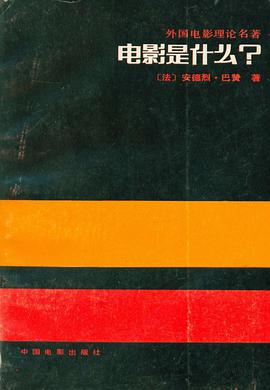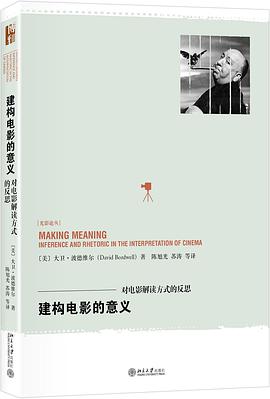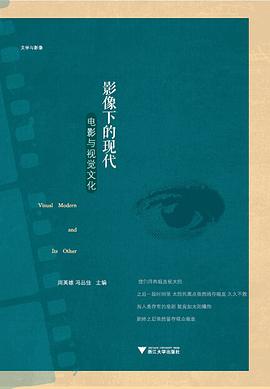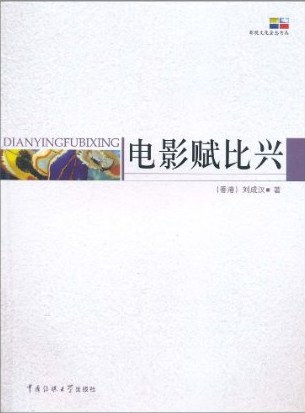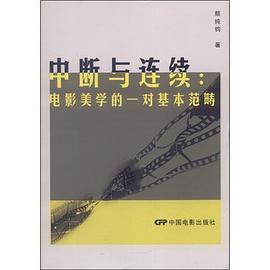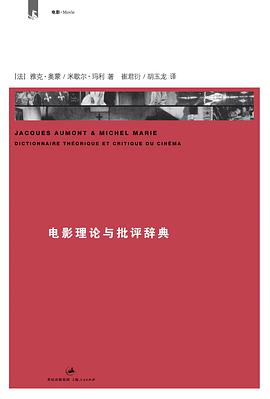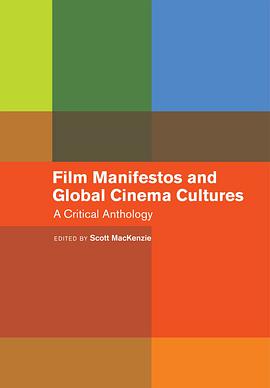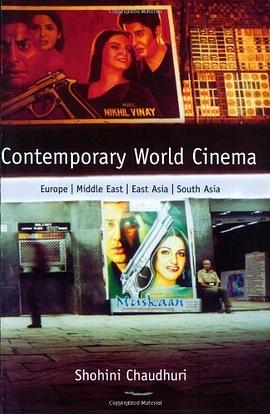电影理论
建构电影的意义 豆瓣
作者:
[美] 大卫·波德维尔 (David Bordwell)
译者:
陈旭光
/
苏涛
北京大学出版社
2017
- 11
《建构电影的意义:对电影解读方式的反思》是著名电影理论家大卫·波德维尔的一部关于电影阐释与批评的著作,也是我们解读电影和展开电影批评的必备参考书,被电影理论家西摩·查特曼赞誉为“一部只有波德维尔才能完成的脉络清晰、纵横捭阖、旁征博引而又严谨的著作”。
在书中,波德维尔结合大量的案例,以探本溯源的民族志学者的理性冷静,回溯并检视了西方电影史上的电影阐释和批评实践,对受结构主义、符号学、精神分析学、文化主义等理论影响的各种电影解读模式进行了系统的反思和批判,揭示出电影批评是如何成为一种机制惯例和逻辑推理活动的。而在文末,波德维尔更是提出“不要解读电影”,提醒读者在阐释性批评之外还可以有别的选择。
在书中,波德维尔结合大量的案例,以探本溯源的民族志学者的理性冷静,回溯并检视了西方电影史上的电影阐释和批评实践,对受结构主义、符号学、精神分析学、文化主义等理论影响的各种电影解读模式进行了系统的反思和批判,揭示出电影批评是如何成为一种机制惯例和逻辑推理活动的。而在文末,波德维尔更是提出“不要解读电影”,提醒读者在阐释性批评之外还可以有别的选择。
电影艺术观念 豆瓣
作者:
游飞
/
蔡卫
北京大学出版社
2009
- 7
《电影艺术观念》是一部全面阐述世界电影艺术观念的著作,其显著特色在于将权威的电影学术理论与生动的电影艺术创作结合在一起,将清晰的电影历史脉络与鲜明的电影艺术家个性结合在一起,将独特的电影艺术表达与多元的国际社会文化及哲学美学背景结合在一起,打通学术性与实践性之间的壁垒,形成一种深入浅出、雅俗共赏的写作风格,让读者在轻松阅读之中汲取电影艺术素养。
《电影艺术观念》是一部电影艺术理论著作(涉及好莱坞经典叙事体系、蒙太奇、长镜头、现代及后现代电影观念),又不乏对电影艺术家进行的创作个案研究(涉及格里菲斯、爱森斯坦、奥森·威尔斯、戈达尔、伯格曼和科波拉等电影艺术大师),它还可以被当作一本风格独特的世界电影史(涉及类型电影、先锋派、纪录电影、新现实主义、“新浪潮”、新好莱坞和独立电影等重要流派)。
《电影艺术观念》是一部电影艺术理论著作(涉及好莱坞经典叙事体系、蒙太奇、长镜头、现代及后现代电影观念),又不乏对电影艺术家进行的创作个案研究(涉及格里菲斯、爱森斯坦、奥森·威尔斯、戈达尔、伯格曼和科波拉等电影艺术大师),它还可以被当作一本风格独特的世界电影史(涉及类型电影、先锋派、纪录电影、新现实主义、“新浪潮”、新好莱坞和独立电影等重要流派)。
中断与连续:电影美学的一对基本范畴 豆瓣
作者:
颜纯钧
中国电影出版社
2013
数字技术在电影中日益广泛运用,正在给电影开辟新的艺术探索的空间,也引发新一轮的电影美学的思考。关注这个新趋势、探索这个方面的新进展,才是今天的电影研究所面临的任务。《中断与连续:电影美学的一对基本范畴》以时下流行的“重返电影美学”这一口号为契机,层层切入并剖析了重返究竟返回到哪里?重返之后又将如何?传统的电影美学已经做了些什么?它又会给今天的电影美学研究提供怎样的基础和启示?
电影理论与批评辞典 豆瓣
Dictionnaire théorique et critique du cinéma
6.8 (5 个评分)
作者:
[法] 雅克·奥蒙
/
米歇尔·玛利
译者:
崔君衍
/
胡玉龙
上海人民出版社
2011
- 5
电影正式成为大众化演出形式之后,就引起了哲学家、社会学家和心理学家的兴趣,也引起了一些颇有远见的艺术批评家或新闻记者的关注。不久,电影导演也依据自己的独特视点延续了这类思考,且理论力度往往毫不逊色,甚至有过之而无不及。几十年来,这两批人常常通过提出新语汇或利用翻新的旧概念,使用和确定了一套专门术语。辞典的作者雅克•奥蒙和米歇尔•玛利有意对自始以来的这批新语汇作一番盘点。
辞典收入了近400个单词或专有名词,记入不同作者按照不同研究学科赋予它们的意义。读者如若希望拓展与深化自己的知识,可深入阅读每个词条后标明的和书末列举的诸多参考书籍。辞典还提及那些创造了或激发了比较深入和系统的批评或理论思考的人物(导演、批评家和理论家)或历史事件(尤其是类型片),所取概念则分属各学科领域:美学、符号学、心理学、艺术和再现形式史,等等。
这部辞典意在见证电影研究的现况、它的丰富多彩和它的已逾百年的历史。这部辞典亦希望见证电影研究的国际性,因为自1910年代始,德国、意大利、英国和北美的作者已经表达了各种见解,只是法国电影癖好的锋芒使它们稍显暗淡。因此,这部辞典不仅面向专攻电影的莘莘学子,同时也更广泛地面向所有希望认真思考自己的心仪之物的电影发烧友。
《电影理论与批评辞典》以辞书的形式汇集了电影理论批评的范畴,以全面的阐释展现了电影文化研究的视野,以简练的文字传播了电影学术探索的常识,是培养艺术教育素质的一部值得阅读和值得参考的读物。
——刘利民教授
电影是当今艺术最重要的形式之一。电影创作和电影理论是发展电影艺术的两翼,是推动电影艺术发展的重要源泉。电影研究已经成为高等教育中引人关注的重要课题。这部辞书用全景式的视野,为我们梳理了电影艺术、技术的理论,并广泛涉及了人文社会学科及电影创作、历史、理论的诸多领域,有助于电影专业人士和电影学习者开阔研究电影的视野。
——张会军教授
北京电影学院院长
辞典收入了近400个单词或专有名词,记入不同作者按照不同研究学科赋予它们的意义。读者如若希望拓展与深化自己的知识,可深入阅读每个词条后标明的和书末列举的诸多参考书籍。辞典还提及那些创造了或激发了比较深入和系统的批评或理论思考的人物(导演、批评家和理论家)或历史事件(尤其是类型片),所取概念则分属各学科领域:美学、符号学、心理学、艺术和再现形式史,等等。
这部辞典意在见证电影研究的现况、它的丰富多彩和它的已逾百年的历史。这部辞典亦希望见证电影研究的国际性,因为自1910年代始,德国、意大利、英国和北美的作者已经表达了各种见解,只是法国电影癖好的锋芒使它们稍显暗淡。因此,这部辞典不仅面向专攻电影的莘莘学子,同时也更广泛地面向所有希望认真思考自己的心仪之物的电影发烧友。
《电影理论与批评辞典》以辞书的形式汇集了电影理论批评的范畴,以全面的阐释展现了电影文化研究的视野,以简练的文字传播了电影学术探索的常识,是培养艺术教育素质的一部值得阅读和值得参考的读物。
——刘利民教授
电影是当今艺术最重要的形式之一。电影创作和电影理论是发展电影艺术的两翼,是推动电影艺术发展的重要源泉。电影研究已经成为高等教育中引人关注的重要课题。这部辞书用全景式的视野,为我们梳理了电影艺术、技术的理论,并广泛涉及了人文社会学科及电影创作、历史、理论的诸多领域,有助于电影专业人士和电影学习者开阔研究电影的视野。
——张会军教授
北京电影学院院长
Film Manifestos and Global Cinema Cultures 豆瓣
作者:
Scott MacKenzie (ed.)
Publisher University of California Press
2014
Review
"The most important film book of the year . . . required reading for both students and lovers of cinema."
(CHOICE 2014-09-01)
Fr om the Inside Flap
"This book offers an exciting and productive way of thinking about cinema, allowing the reader to become acquainted with a large range of important declarations on film and on its mission from across its history. This is a volume that every film scholar will want to have."
—Dana Polan, Professor of Cinema Studies, New York University
"Embracing the entire history of cinema, this work maps in detail territory barely explored hitherto, and is fully contextualized through historically informed and theoretically informative commentary that places the manifesto at the heart of film history and film culture. A hugely impressive achievement."
—Annette Kuhn, co-author of the Oxford Dictionary of Film Studies
"This is a galvanizing collection of hundreds of calls to arms for the cinema. It's an inspiring affirmation of the core vitality of this most important art across decades and throughout the world."
—Bill Nichols, author of Introduction to Documentary, 2nd edition, and Engaging Cinema
Film Manifestos and Global Cinema Cultures is the first book to collect manifestoes from the global history of cinema, providing the first historical and theoretical account of the role played by film manifestos in filmmaking and film culture. Focussing equally on political and aesthetic manifestoes, Scott MacKenzie uncovers a neglected, yet nevertheless central history of the cinema, exploring a series of documents that postulate ways in which to re-imagine the cinema and, in the process, re-imagine the world.
This volume collects the major European “waves” and figures (Eisenstein, Truffaut, Bergman, Free Cinema, Oberhausen, Dogme ‘95); Latin American Third Cinemas (Birri, Sanjinés, Espinosa, Solanas); radical art and the avant-garde (Buñuel, Brakhage, Deren, Mekas, Ono, Sanborn); and world cinemas (Iimura, Makhmalbaf, Sembene, Sen). It also contains previously untranslated manifestos co-written by figures including Bollaín, Debord, Hermosillo, Isou, Kieslowski, Painlevé, Straub, and many others. Thematic sections address documentary cinema, aesthetics, feminist and queer film cultures, pornography, film archives, Hollywood, and film and digital media. Also included are texts traditionally left out of the film manifestos canon, such as the Motion Picture Production Code and Pius XI's Vigilanti Cura, which nevertheless played a central role in film culture.
"The most important film book of the year . . . required reading for both students and lovers of cinema."
(CHOICE 2014-09-01)
Fr om the Inside Flap
"This book offers an exciting and productive way of thinking about cinema, allowing the reader to become acquainted with a large range of important declarations on film and on its mission from across its history. This is a volume that every film scholar will want to have."
—Dana Polan, Professor of Cinema Studies, New York University
"Embracing the entire history of cinema, this work maps in detail territory barely explored hitherto, and is fully contextualized through historically informed and theoretically informative commentary that places the manifesto at the heart of film history and film culture. A hugely impressive achievement."
—Annette Kuhn, co-author of the Oxford Dictionary of Film Studies
"This is a galvanizing collection of hundreds of calls to arms for the cinema. It's an inspiring affirmation of the core vitality of this most important art across decades and throughout the world."
—Bill Nichols, author of Introduction to Documentary, 2nd edition, and Engaging Cinema
Film Manifestos and Global Cinema Cultures is the first book to collect manifestoes from the global history of cinema, providing the first historical and theoretical account of the role played by film manifestos in filmmaking and film culture. Focussing equally on political and aesthetic manifestoes, Scott MacKenzie uncovers a neglected, yet nevertheless central history of the cinema, exploring a series of documents that postulate ways in which to re-imagine the cinema and, in the process, re-imagine the world.
This volume collects the major European “waves” and figures (Eisenstein, Truffaut, Bergman, Free Cinema, Oberhausen, Dogme ‘95); Latin American Third Cinemas (Birri, Sanjinés, Espinosa, Solanas); radical art and the avant-garde (Buñuel, Brakhage, Deren, Mekas, Ono, Sanborn); and world cinemas (Iimura, Makhmalbaf, Sembene, Sen). It also contains previously untranslated manifestos co-written by figures including Bollaín, Debord, Hermosillo, Isou, Kieslowski, Painlevé, Straub, and many others. Thematic sections address documentary cinema, aesthetics, feminist and queer film cultures, pornography, film archives, Hollywood, and film and digital media. Also included are texts traditionally left out of the film manifestos canon, such as the Motion Picture Production Code and Pius XI's Vigilanti Cura, which nevertheless played a central role in film culture.
Contemporary World Cinema 豆瓣
作者:
Shohini Chaudhuri
Edinburgh University Press
2006
- 5
Since the start of the 1990s, despite tougher competition than ever before from Hollywood, a rebirth and flourishing of cinema has been taking place in parts of Europe, the Middle East, East Asia and South Asia. This book provides an overview of the cinemas of these regions, interpreting some of the recent developments as strategic responses to globalisation. Highlighting transnational and cross-cultural structures, influences and themes, it offers: * A broad critical context for the study of contemporary world cinema, introducing key concepts and issues including modes of production and distribution. * Cultural and historical background for the cinemas of each region, with analyses of regional aesthetic styles and comparisons with Hollywood models. * Case studies of Scandinavian, Iranian, Hong Kong and Indian cinema. * Close analysis of twelve landmark films, including Thomas Vinterberg's Festen, Samira Makhmalbaf's The Apple, Wong Kar-Wai's In the Mood For Love, and Ashutosh Gowariker's Lagaan. Contemporary World Cinema is vital for students and teachers of film, media, cultural studies and modern languages, as well as general world cinema enthusiasts.
